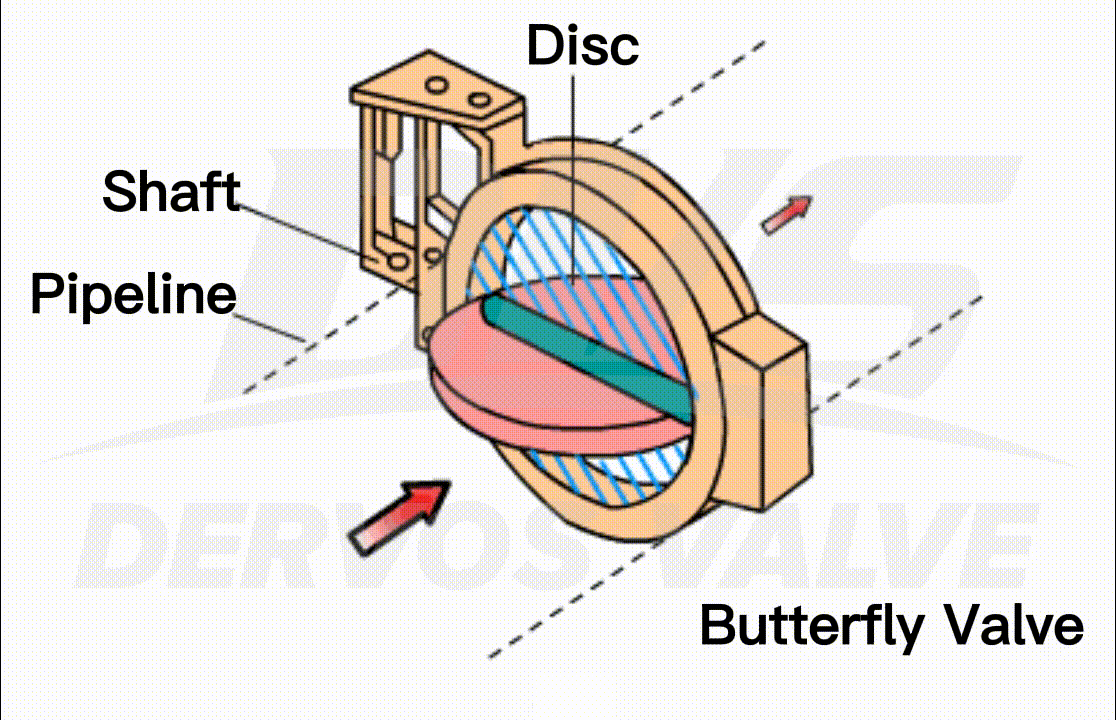This article provides a comprehensive overview of butterfly valve types, including wafer type, double offset, and triple offset butterfly valves. It explains structural differences, application scenarios, selection tips, installation guidelines, and maintenance essentials—designed to help engineers and buyers make informed decisions.
1. How Butterfly Valves Work and Their Core Components
A butterfly valve operates by rotating a disc (the “butterfly”) 90 degrees to regulate or stop fluid flow. Its main components include a valve body, stem, disc, and seat. The sealing interface may use rubber (EPDM/NBR), PTFE, or metal-to-metal contact, depending on the sealing type. Butterfly valves can be connected via wafer, flanged, or welded ends.In addition to full open/close shutoff control, butterfly valves also allow modulating service. When opened between 15° and 70°, they offer relatively accurate flow throttling capability.

Key Advantages of Butterfly Valves:
90° quick quarter-turn operationSpace-saving design and easy installation
Low flow resistance and energy efficiency
Ideal for large-diameter pipelines
Multiple actuation options: manual, electric, pneumatic, hydraulic
2. Types of Butterfly Valves and Technical Comparison
(1) Centerline Butterfly Valve (Soft Seated)
Also known as concentric butterfly valve.Design Principle: The disc and seat share the same centerline. A soft elastic seat (usually rubber or PTFE) ensures tight sealing.
Best for:
Low-pressure, ambient-temperature applications: water, air, seawater, waste
Bidirectional sealing in non-critical systems
Pros:
Most cost-effective type
Simple structure, easy to maintain
Zero leakage in clean systems
Limitations:
Not suitable for high-pressure or high-temperature systems
Rubber seats may age, crack, or deform over time
(2) Double Offset Butterfly Valve (Soft/Metal Seated)
Also known as high-performance butterfly valve (HPBV)Design Principle: The stem is offset from both the center of the disc and the valve body, reducing friction during opening/closing and enhancing sealing durability.
Best for:
Medium-pressure systems (PN10–PN40)
Slightly corrosive or frequently operated lines
Pros:
Lower operating torque
Longer seat life due to reduced wear
Flexible sealing options (soft or metal)
Limitations:
Requires higher precision manufacturing
Seat adjustment or replacement can be more complex

(3) Triple Offset Butterfly Valve (Metal Seated, Critical Service)
Design Principle: Adds a third offset angle between the disc seal and valve body seat, forming a conical shape. The result is friction-free sealing, suitable for zero-leakage in high-stress environments.Best for:
High-temperature and high-pressure applications (up to 42.0 MPa)
Abrasive, corrosive, or high-cycling processes
Replacing gate, globe, or ball valves in critical lines
Pros:
Metal-to-metal seal, temperature resistance up to 600°C
Bi-directional zero leakage
Ideal for DN1000+ pipelines
Limitations:
Higher cost
Requires expert installation and actuator pairing

3. Quick Selection Guide for Butterfly Valves
Application Recommended TypeDN1000+ large pipelines Double or triple offset
Flow regulation tasks Double offset (HPBV)
Neutral, low-pressure fluids Soft-seated centerline valve
High-temp / corrosive fluids Triple offset, metal seated
High-cycle actuation Pneumatic or electric butterfly valve
Severe sealing requirements Triple offset with bi-directional seal
4. Butterfly Valve FAQ: Technical Buyer Questions
Q1: Why are butterfly valves commonly used in large-diameter pipes?Because of their short face-to-face design, lightweight structure, and low torque, butterfly valves are ideal for large bore, low-pressure or modulating systems. They are space-saving and cost-effective.
Q2: Can concentric butterfly valves be used for high-temperature service?
Not recommended. Soft seats such as rubber or PTFE degrade under high temperatures. Use a metal seated double or triple offset butterfly valve for high-temp or steam service.
Q3: Is triple offset valve the only option for bi-directional sealing?
No. Centerline valves offer bi-directional sealing under low pressure. However, for critical or high-pressure systems, triple offset butterfly valves ensure zero leakage in both directions.
Q4: What should I do if a butterfly valve starts leaking?
Inspect for worn seals or loosened gland packing. If parts are still intact, consider using valve lubricant or temporary sealant. If the leakage persists, replace the seat or valve.
Q5: Are electric butterfly valves suitable for outdoor installation?
Yes, but ensure the actuator is IP67 or higher rated. For cold climates, add anti-condensation heaters or insulation kits to prevent freezing or failure.
Conclusion
As one of the most widely used industrial valve types, butterfly valves are evolving toward higher sealing integrity, better temperature and pressure tolerance, and smarter automation control. From centerline to triple offset designs, and from soft seats to metal seats, each structure serves a specific purpose. Selecting the right butterfly valve depends on the system’s pressure, temperature, media, and control needs.For custom selection charts, material compatibility tables, or industry case studies, feel free to contact DVS technical team for expert support.
